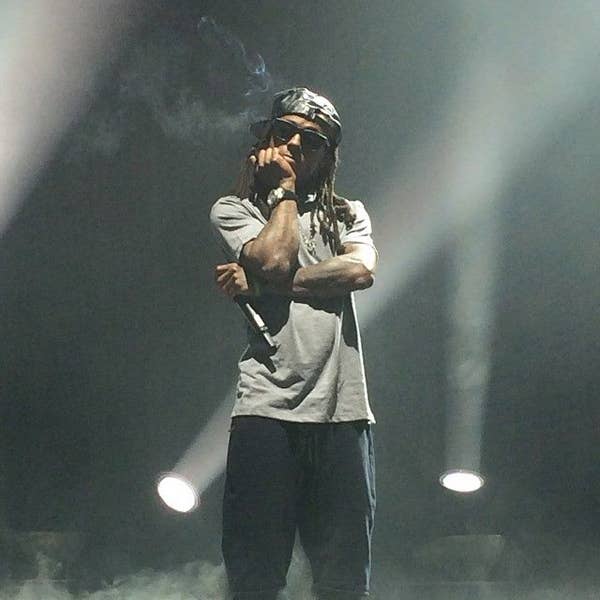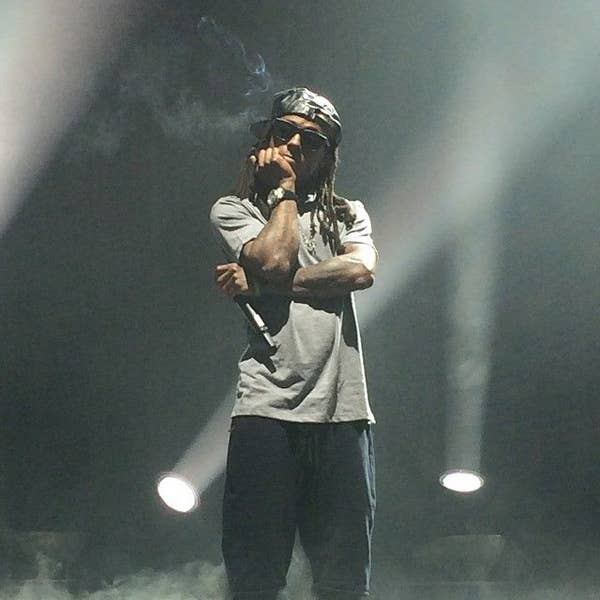1.

Image via Facebook
At his peak, Lil Wayne was a force. He was the self-proclaimed best rapper alive and his technical skills were undeniable, but it was more than that. At his peak, Lil Wayne was unpredictable.
It’s hard to pinpoint exactly when Wayne’s apex was, but it started sometime around the release of 2006’s Dedication 2 mixtape with DJ Drama. By that point, Tha Carter II had already been released and Wayne had shown flashes of brilliance, but there was something magical about the mixtape side to him. It was raw, unfiltered, but devastatingly focused. Even through his free-association rhymes and sometimes nonsensical train of thought, there was a sharpness to Lil Wayne’s grasp of language and delivery that was unparalleled. Later that year, he put out the criminally underrated Like Father, Like Son with Birdman, and in 2007 he dropped Da Drought 3, featuring some of his most technically advanced rapping ever. 2008 brought his most successful album, Tha Carter III, which sold over a million in its first week, went triple-Platinum, and yielded an eclectic batch of singles including “Lollipop,” “A Milli,” “Mr. Carter,” “Got Money,” and “Mrs. Officer.”
2010 is perhaps when Lil Wayne’s decline began. Rebirth was a polarizing album, but it was Wayne being a fucking rockstar and although it wasn’t critically acclaimed, it opened up the doors for experimentation, even for the most commercially successful artists. This was Wayne doing what Wayne wanted, and it was the pinnacle of unpredictability in an industry that all too often favors safe, formulaic approaches.
This was Wayne doing what Wayne wanted, and it was the pinnacle of unpredictability in an industry that all too often favors safe, formulaic approaches.
Since then, Lil Wayne has been underwhelming. There are still flashes of the old Wayne, but the bad punchlines and same old flows are getting played out. We haven’t heard something completely new from Lil Wayne in almost half a decade. Sometime after Rebirth, Lil Wayne stopped evolving. Maybe it had something to do with his waning drug use or his new dedication to skateboarding. Or maybe Wayne was just finally exhausted. If you ever saw the fascinating The Carter documentary, you know that for years, he went in non-stop, recording wherever he went, no matter what. He wasn’t just at home recording on a computer and uploading tracks to SoundCloud, as is so common today. He was putting together makeshift studios in hotel rooms and recording during downtime from playing stadiums around the world. He was also handing out show-stealing features for chart-topping artists and helping build the careers of Young Money artists like Drake and Nicki Minaj. And he still found time to make the best music of his career. In those years before his eventual comedown, Lil Wayne was putting in serious work.
But another interesting thing happened. As Wayne started to fall off, dozens of Wayne-inspired artists started to come up, most notably two of the hottest current rappers out: Future and Young Thug. Without Wayne’s relentless experimentation with melody, warped deliveries and pronunciations, absurd wordplay, and *gasp* Auto-Tune, let’s face it: Future and Young Thug would have likely been relegated to the lower ranks of niche obscurity. By putting out songs like “Prostitute Flange” and “I Feel Like Dying” while still making mainstream hits, Lil Wayne helped expand the palettes of casual rap fans. Other commercially successful artists weren’t making music like that pre-2010. In 2009, the highest selling rap albums were Eminem’s Relapse, Jay Z’s The Blueprint 3, Rick Ross’ Deeper Than Rap, and 50 Cent’s Before I Self Destruct.
Like Lil Wayne, Future and Young Thug know how to work. To the outside world, their lives may seem consumed by drugs, women, and partying, but anyone who has seen them in action can vouch—they are constantly working, always staying productive. In 2013, Young Thug explained, “I don’t write. When I’m at home, I’m with my kids. But if I think of one word that will stick I’ll go straight to the studio because it will be on my mind and I know I can make one song off one word. If something hits me I’ll totally go straight to the studio.” When I met him for a photo shoot in 2014, we finished around 8 p.m., after a full day in an Atlanta studio. When we were done, he hopped in a van and drove over five hours to North Carolina for a late night show.
As with Wayne at his peak, there’s a sense of urgency, like this magic might not last forever, and every modicum of creativity needs to be harnessed.
Now it’s 2015, and as I was listening to Lil Wayne’s underwhelming Free Weezy Album, I clung on to the hope that a Wayne comeback was still possible. Keep in mind, he’s still young—Kanye West is making some of the most progressive hip-hop at age 38, and Lil Wayne is still only 32. The new mixtape shows that Wayne is still a capable rapper. Songs like “Glory” and “Post Bail Ballin’” have Wayne rapping well, and “I Feel Good” and “He’s Dead” prove that he can still put together a cohesive concept, but nothing captures that same thrill of hearing a new Lil Wayne verse in the late 2000s. My personal favorite song on the project is “London Roads,” produced by frequent Young Thug collaborator London On Da Track, but as I was playing it for a friend, he said something that made me realize what has happened.
“This is alright,” he admitted, “but it’s just that same half-rapping, half-singing flow that everyone’s doing.”
This is when it sunk in: Wayne laid out a blueprint for the newcomers who would come along and change the sound of popular contemporary rap, but while they all evolved and took hip-hop into strange and fascinating new places, Lil Wayne fell behind. While Young Thug and Future keep things interesting, Wayne has become a less compelling, less innovative version of his old self. And today, young fans who spent the last few years listening as rap music moved into alien territories are detached from the artist who inspired this all. This guy who claimed to be a Martian/animal/monster/beast for so many years now seems tame, normal, and predictable. He has become comparatively boring.
In music, creativity is a fleeting thing. Few artists can avoid the ebbs and flows, and once inspiration has retreated, it rarely comes back. In a few cases, like Johnny Cash and Jay Z, we’ve seen a resurgence of innovation, but it’s highly uncommon. With Lil Wayne, I hope that he’ll be able to tap into that otherworldly level of imagination again, but as we watch his students lap him, it seems less and less likely with each release.
Rap music is a particularly unforgiving genre—it’s still so young that even styles from five years ago seem outdated and unexciting, and the life cycle for a rap artist is short, relatively speaking. A few legends last, but most hip-hop fans don’t want to listen to middle-aged men and women revisiting boom bap beats or deliveries popularized last summer. Evolution is essential to relevance.
Maybe one of the problems with Lil Wayne is that while he was busy proclaiming his dominance, he failed to keep an ear out for what was happening all around him. On “Best Rapper Alive,” his dismissal of newcomers now reads like an unfortunate foreshadowing of his own dethroning.
Fuck up wit all these rookie MCs?
Whew! Smell like a bunch of pussy to me
Fuck em!
Fuck ’em good
Fuck ’em long
Fuck ’em hard
Fuck who? Fuck ’em all
With classics under his belt and some of the hottest current rappers citing Wayne as an inspiration, his spot in hip-hop history is cemented. He’ll live on through his influence, but the Free Weezy Album seems like one of his last gasps. Future’s album is coming, Young Thug’s plotting a tape with London On Da Track, and even if Wayne returns in top form, the context has changed. Lil Wayne is no longer the leader. Now he’s struggling just to keep up.



